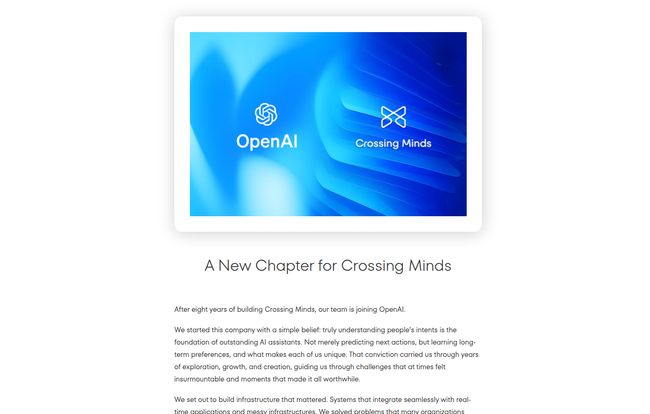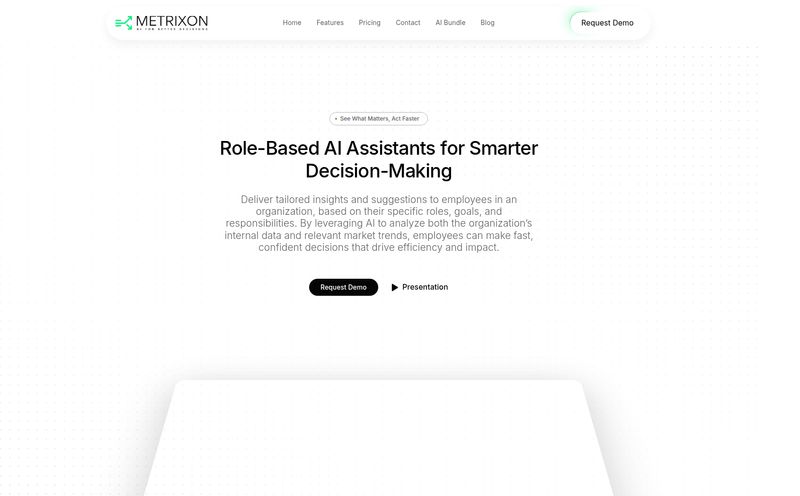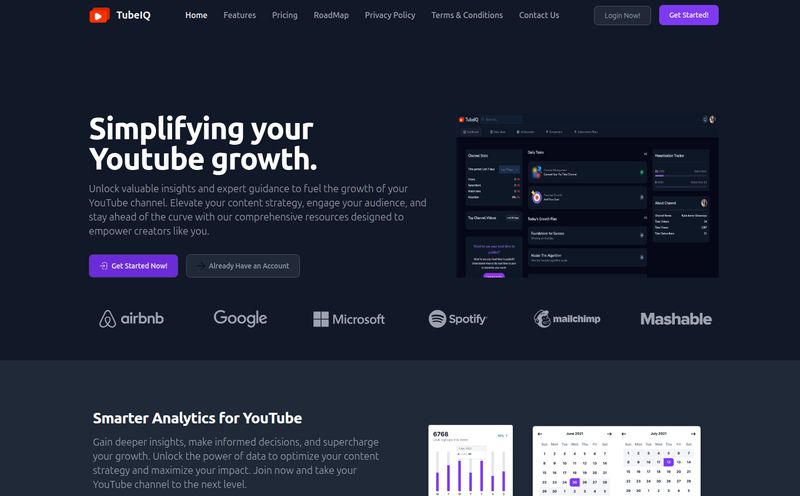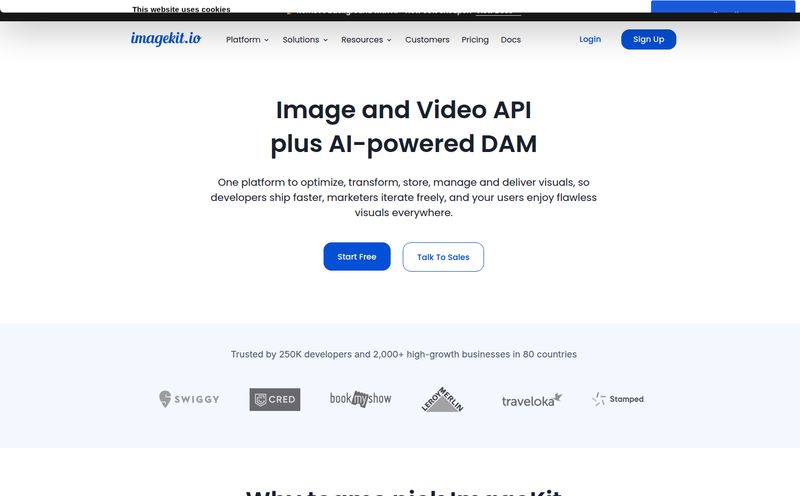If you've been in the enterprise AI or e-commerce tech space for a while, you've probably heard the name Crossing Minds. They were one of those companies doing some seriously cool, under-the-radar work in personalization. And if you've recently tried to check out their website... well, you were probably greeted by a 404 error page. A digital ghost town.
So, what gives? Did they just pack up and go on vacation?
Not quite. They went on the ultimate tech vacation: they got acquired. And not just by anyone. The team behind Crossing Minds is now part of OpenAI. Yep, that OpenAI.
When I saw the announcement, my first thought was, “Well, that makes perfect sense.” My second thought was, “This is a pretty big deal for the future of personalized AI.” Let’s break down what Crossing Minds was, what made them so special, and what this move really means for all of us watching the AI space.

Visit Crossing Minds
So, What Exactly Was Crossing Minds?
At its heart, Crossing Minds was an AI Ops platform built for one thing: ridiculously smart personalization and information retrieval. Think of it as a recommendation engine on steroids. While most platforms look at what you’ve clicked on and say, “You might also like this other blue shirt,” Crossing Minds aimed to understand the why. The actual human intent.
In their own farewell message, the founders—Alexandre, Emile, and team—said they started the company to truly understand people’s intents, not just predict the next click. That’s a subtle but massive difference. It's the gap between an assistant who fetches what you ask for and one who anticipates what you actually need. They served big players in retail, streaming, and even finance, helping them create user experiences that felt less like an algorithm and more like a conversation.
The Tech That Got OpenAI's Attention
You don't get acquired by a titan like OpenAI by just having a nice-looking PowerPoint deck. You need some serious firepower under the hood. Crossing Minds had it in spades. This wasn't just your standard collaborative filtering setup.
Beyond Simple Recommendations
The real magic, from my perspective, was in their advanced tech stack. We're talking about things like Next-Gen Embeddings and, the star of the show, Retrieval-Augmented Generation (RAG). If you're not a total AI nerd, RAG is a way to make Large Language Models (LLMs) smarter and more accurate. Think of it like this: instead of asking a genius to answer a question from memory alone, you give them a library of up-to-date, relevant books to reference before they speak. This grounds the AI's response in factual, current data, which is a massive challenge for models like ChatGPT. Crossing Minds was applying this to enterprise search and personalization long before it became a mainstream buzzword.
Real-Time Everything
Another killer feature was its real-time performance. In the world of e-commerce or content streaming, personalization based on data from last week is already ancient history. A user’s intent can change in seconds. Crossing Minds built their infrastructure to process data and update recommendations on the fly, making the user experience incredibly dynamic. That's a difficult engineering problem to solve at scale, and they clearly cracked it.
A Composable, Developer-Friendly Approach
I’ve worked with enough enterprise clients to know they hate black boxes. They want flexibility. Crossing Minds offered a composable stack with flexible APIs, meaning developers could pick and choose the components they needed and integrate them into their existing systems. This is so much more appealing than being forced to rip and replace your entire infrastructure for one new tool. Smart move.
Why This Acquisition is a Game-Changer (My Take)
Okay, here’s my two cents. This isn't just a simple talent grab, though it’s definitely that too. This is a deeply strategic move by OpenAI.
OpenAI has conquered the consumer-facing AI world with ChatGPT. Their next frontier? Enterprise. They have ChatGPT Enterprise, sure, but to truly dominate, they need to offer more than just a powerful chatbot. They need to provide solutions that plug directly into a business's core operations and solve specific, high-value problems. And what problem is more valuable than understanding your customers and selling them more stuff?
The Crossing Minds team brings years of battle-tested experience in exactly that. They know how to handle real-world, messy enterprise data. They know how to build and deploy scalable personalization engines that actually drive metrics like conversion rates and sales. They are, in essence, a shortcut for OpenAI into the nitty-gritty of applied commercial AI. OpenAI now has a team that can help them build products that don't just generate text, but generate revenue for their customers.
I think we'll see the DNA of Crossing Minds show up in future OpenAI products geared towards commerce, customer service, and hyper-personalized user experiences. Imagine a version of ChatGPT for an online store that doesn't just answer questions about a product but knows your style, your past purchases, and what you're likely looking for next. That's the future these guys were building, and now they'll be doing it with OpenAI's immense resources.
What About Pricing and the Platform?
One of the running quirks of Crossing Minds was that their pricing was never public. It was a classic “contact us for a demo” enterprise sales model. This suggests their solution was a premium, highly-customized product, not a cheap off-the-shelf plugin. Given their client list and the complexity of their tech, that’s not surprising.
As for the platform itself, it's safe to say the standalone Crossing Minds product is no more. The lights are off and teh website is a 404 page. The technology and expertise haven't vanished, though. They've just been absorbed into a much larger mothership. Former customers were likely given a transition plan as part of the acquisition process, which is standard procedure.
Frequently Asked Questions (FAQ)
What was Crossing Minds?
Crossing Minds was an advanced AI platform focused on enterprise personalization and intelligent information retrieval. It used real-time data and sophisticated AI models like RAG to help businesses in e-commerce, streaming, and other industries deliver highly personalized experiences to their users.
Why did OpenAI acquire Crossing Minds?
This was likely a strategic acquisition to bring in a team with deep expertise in applying AI for commercial enterprise solutions. Crossing Minds' specialization in real-time personalization, RAG, and handling complex business data directly complements OpenAI's goal of expanding its enterprise offerings.
Can I still use the Crossing Minds platform?
No, the standalone Crossing Minds platform is no longer available. The company's team and technology have been integrated into OpenAI.
What is RAG (Retrieval-Augmented Generation)?
RAG is a technique that enhances the accuracy and relevance of Large Language Models (LLMs). It allows the model to retrieve information from an external, authoritative knowledge base before generating a response, kind of like an open-book exam. This helps reduce hallucinations (making stuff up) and keeps the AI's knowledge current.
Was Crossing Minds expensive?
Pricing was not made public, but as a high-end enterprise solution, it was likely a significant investment tailored to the complex needs of large companies. It was not a self-serve, low-cost tool.
What does this mean for the future of enterprise AI?
This acquisition highlights a major trend: the move from generic AI to specialized, personalized AI that solves specific business problems. It signals that the biggest players in AI are focusing heavily on how their models can be practically applied to drive business metrics like sales and customer loyalty.
A New Chapter Indeed
At the end of the day, the story of Crossing Minds is a success story. A talented team built something truly innovative, got incredible results for their clients, and caught the eye of the biggest name in the game. While we can't sign up for their platform anymore, their influence is about to get a whole lot bigger. I, for one, am really excited to see what this brilliant team builds next from inside the walls of OpenAI. It's a big win for them, and potentially, an even bigger win for the future of AI.



